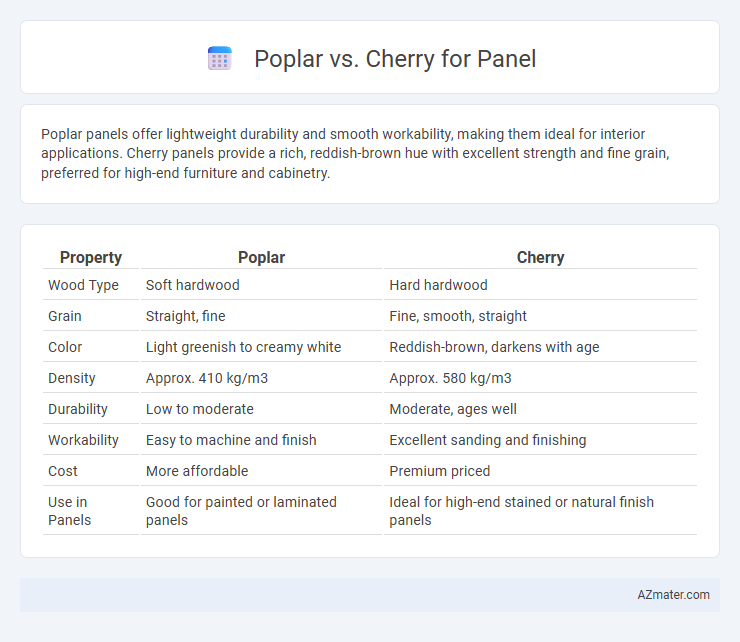Poplar panels offer lightweight durability and smooth workability, making them ideal for interior applications. Cherry panels provide a rich, reddish-brown hue with excellent strength and fine grain, preferred for high-end furniture and cabinetry.
Table of Comparison
| Property | Poplar | Cherry |
|---|---|---|
| Wood Type | Soft hardwood | Hard hardwood |
| Grain | Straight, fine | Fine, smooth, straight |
| Color | Light greenish to creamy white | Reddish-brown, darkens with age |
| Density | Approx. 410 kg/m3 | Approx. 580 kg/m3 |
| Durability | Low to moderate | Moderate, ages well |
| Workability | Easy to machine and finish | Excellent sanding and finishing |
| Cost | More affordable | Premium priced |
| Use in Panels | Good for painted or laminated panels | Ideal for high-end stained or natural finish panels |
Introduction to Poplar and Cherry Wood for Panels
Poplar wood is a lightweight, fine-grained hardwood known for its affordability and easy workability, making it a popular choice for interior panels and furniture components. Cherry wood offers a rich, warm reddish-brown color and smooth texture, valued for its durability and natural aging process that deepens its hue over time, ideal for high-end cabinetry and decorative panels. Both woods provide distinct aesthetic and functional benefits, with poplar favored for cost-effective, painted surfaces and cherry preferred for premium, natural finishes.
Key Characteristics of Poplar Wood
Poplar wood is lightweight, soft, and easy to machine, making it an ideal choice for interior panels and applications requiring frequent handling or intricate shaping. Its pale, uniform color with slight green or yellow hues allows for smooth staining and painting, providing versatility in design. Poplar also offers good dimensional stability and resistance to warping, though it is less durable and less resistant to decay than cherry wood.
Key Characteristics of Cherry Wood
Cherry wood is prized for its rich, warm reddish-brown color that deepens over time, adding elegance to panels and furniture. Its fine, straight grain and smooth texture create a sophisticated, uniform appearance ideal for high-quality woodworking. Cherry wood is also durable and moderately hard, making it resistant to dents and scratches while still being relatively easy to work with compared to harder hardwoods like oak.
Visual Appearance: Poplar vs Cherry
Poplar panels exhibit a light, creamy-white color with subtle green or brown streaks, offering a smooth and uniform appearance that complements contemporary designs. Cherry panels feature rich, warm reddish-brown hues that deepen and develop a natural patina over time, providing a classic and elegant look. The distinct grain patterns and vibrant color evolution of cherry contrast with the more understated, consistent visual texture of poplar, making cherry ideal for traditional aesthetics while poplar suits modern, minimalist spaces.
Workability and Machinability Comparison
Poplar offers superior workability with its soft texture and uniform grain, making it easier to cut, shape, and sand compared to cherry. Cherry, while harder and denser, provides good machinability but requires sharper tools and slower feed rates to prevent burning or tear-out during panel production. Both woods perform well in panel applications, but poplar is preferred for intricate machining while cherry excels in durability and finish quality.
Durability and Strength Differences
Poplar is a softer wood with lower density, making it less durable and strong compared to cherry, which has a hardwood composition known for its superior strength and resistance to wear. Cherry panels exhibit better impact resistance and maintain structural integrity under heavy use, while poplar tends to dent and scratch more easily. For applications requiring long-lasting durability and robust support, cherry is the preferred choice due to its hardness rating and natural resilience.
Cost Comparison: Poplar vs Cherry Panels
Poplar panels are significantly more cost-effective than cherry panels, with prices often 30-50% lower due to the faster growth rate and greater availability of poplar wood. Cherry panels offer superior durability and a rich, reddish-brown hue, which increases their market value and justifies the higher price point. For budget-conscious projects, poplar provides an affordable alternative without compromising on workability or finish quality.
Best Applications for Poplar Panels
Poplar panels are best suited for interior applications such as furniture, cabinetry, and decorative paneling due to their lightweight nature, smooth grain, and excellent workability. Their affordability and stability make them ideal for painted finishes or veneer cores, enhancing aesthetics without compromising structural integrity. Compared to cherry, poplar offers a more consistent surface texture and greater versatility for various production methods in woodworking.
Best Applications for Cherry Panels
Cherry panels are ideal for high-end cabinetry, fine furniture, and decorative wall paneling due to their rich, warm tones and smooth grain that enhance aesthetic appeal. Their durability and resistance to warping make them suitable for intricate woodworking and long-lasting applications. The natural aging process of cherry wood adds depth and character, making it preferred for heirloom-quality projects and luxury interiors.
Choosing the Right Wood: Poplar or Cherry for Your Panel Project
Poplar offers a lightweight, cost-effective option with a fine, even grain ideal for painting or staining in panel projects, while cherry provides a rich, warm hue and strong durability favored for premium finishes. Cherry wood darkens gracefully over time, enhancing panel aesthetics, whereas poplar maintains a consistent pale tone better suited for modern or painted designs. Selecting between poplar and cherry depends on the desired finish, budget constraints, and the panel's intended visual impact and longevity.

Infographic: Poplar vs Cherry for Panel
 azmater.com
azmater.com